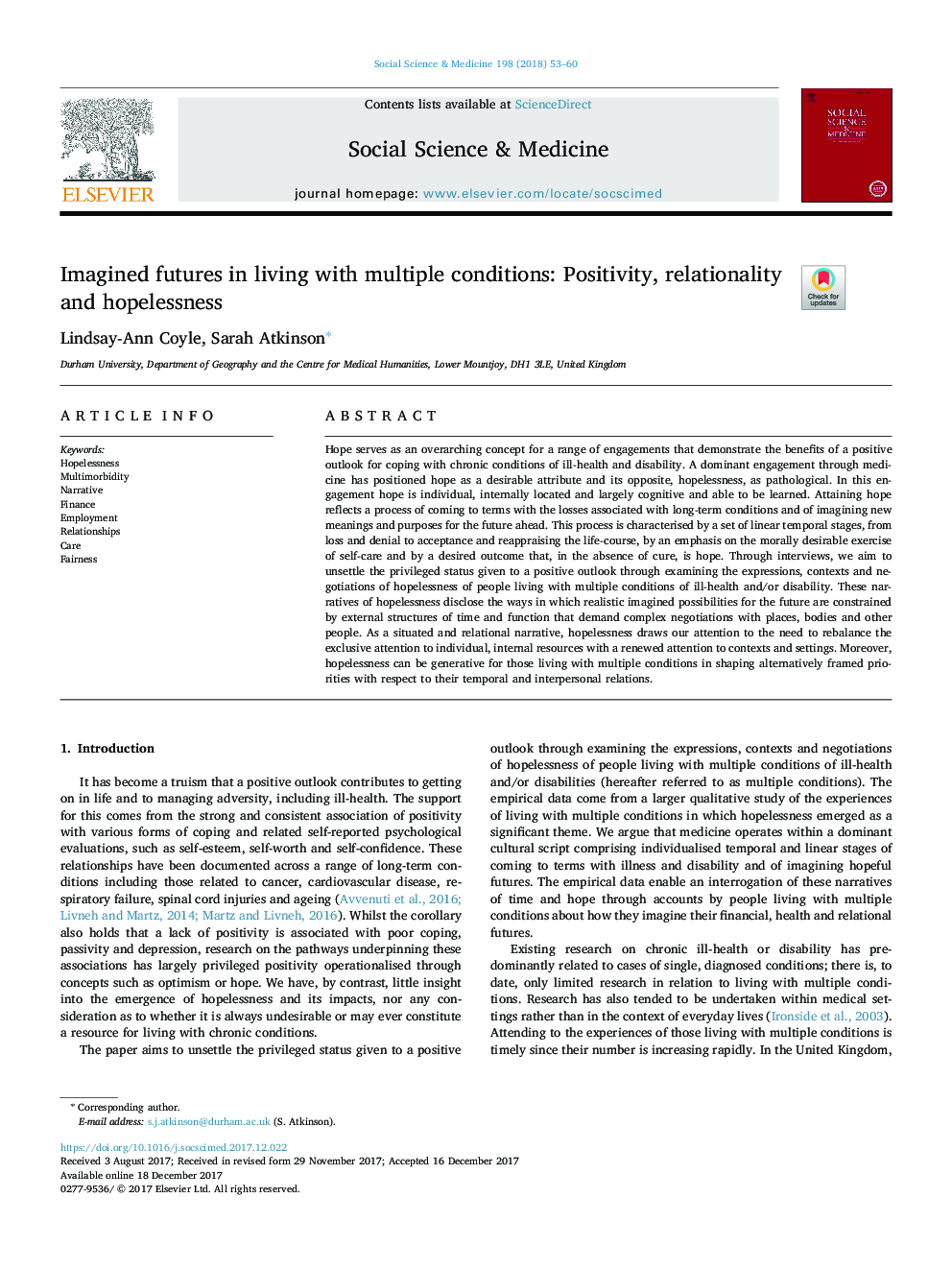| کد مقاله | کد نشریه | سال انتشار | مقاله انگلیسی | نسخه تمام متن |
|---|---|---|---|---|
| 7328586 | 1475971 | 2018 | 8 صفحه PDF | دانلود رایگان |
عنوان انگلیسی مقاله ISI
Imagined futures in living with multiple conditions: Positivity, relationality and hopelessness
ترجمه فارسی عنوان
آینده ی تصور در زندگی با شرایط مختلف: مثبت بودن، رابطه یی و ناامیدی
دانلود مقاله + سفارش ترجمه
دانلود مقاله ISI انگلیسی
رایگان برای ایرانیان
کلمات کلیدی
بی خوابی، چند بیماری روایت، دارایی، مالیه، سرمایه گذاری، استخدام، روابط، اهمیت دادن، عادلانه،
ترجمه چکیده
امید به عنوان یک مفهوم جامع برای طیف وسیعی از مشاغل که نشان دهنده مزایای چشم انداز مثبت برای مقابله با بیماری های مزمن بدبختی و ناتوانی است، عمل می کند. تعامل غالب از طریق پزشکی امید را به عنوان ویژگی مطلوب و مخالفت آن، ناامیدی و پاتولوژیک قرار داده است. امیدوارم در این همکاری فردی، درون محور و عمدتا شناختی باشد و بتواند آموخته شود. به دست آوردن امید نشان دهنده یک فرآیند است که با خسارات مربوط به شرایط دراز مدت و تصور کردن معانی و اهداف جدید برای آینده در پیش می رود. این فرآیند با مجموعه ای از مراحل زمانی خطی، از دست دادن و انکار به پذیرش و بازنگری مسیر زندگی، با تأکید بر عملکرد اخلاقی مطلوب مراقبت از خود و با نتیجه مطلوب که در صورت عدم درمان، مشخص می شود، امید است از طریق مصاحبه ها، ما قصد داریم که از وضعیت معافیت داده شده به یک چشم انداز مثبت، از طریق بررسی معانی، زمینه ها و مذاکرات ناامیدی افرادی که با شرایط مختلف بدرفتاری و / یا معلولیت زندگی می کنند، استفاده شود. این روایتهای ناامیدی راه هایی را نشان می دهد که در آن فرصت های خیالی واقع گرایانه برای آینده توسط ساختارهای خارجی زمان و عملکرد که نیاز به مذاکرات پیچیده با مکان ها، بدن و افراد دیگر را محدود می کند، محدود می شود. ناامیدی به عنوان یک روایت دراز و نشاط، توجه ما را به نیاز مجدداز توجه منحصر به فرد به منابع فردی داخلی با توجه تازه به محیط و تنظیمات جلب می کند. علاوه بر این، ناامیدی می تواند برای کسانی که با شرایط مختلف زندگی می کنند، در شکل دادن اولویت های متفاوتی طراحی شده با توجه به روابط زمانگرائی و بین فردی آنها باشد.
موضوعات مرتبط
علوم پزشکی و سلامت
پزشکی و دندانپزشکی
سیاست های بهداشت و سلامت عمومی
چکیده انگلیسی
Hope serves as an overarching concept for a range of engagements that demonstrate the benefits of a positive outlook for coping with chronic conditions of ill-health and disability. A dominant engagement through medicine has positioned hope as a desirable attribute and its opposite, hopelessness, as pathological. In this engagement hope is individual, internally located and largely cognitive and able to be learned. Attaining hope reflects a process of coming to terms with the losses associated with long-term conditions and of imagining new meanings and purposes for the future ahead. This process is characterised by a set of linear temporal stages, from loss and denial to acceptance and reappraising the life-course, by an emphasis on the morally desirable exercise of self-care and by a desired outcome that, in the absence of cure, is hope. Through interviews, we aim to unsettle the privileged status given to a positive outlook through examining the expressions, contexts and negotiations of hopelessness of people living with multiple conditions of ill-health and/or disability. These narratives of hopelessness disclose the ways in which realistic imagined possibilities for the future are constrained by external structures of time and function that demand complex negotiations with places, bodies and other people. As a situated and relational narrative, hopelessness draws our attention to the need to rebalance the exclusive attention to individual, internal resources with a renewed attention to contexts and settings. Moreover, hopelessness can be generative for those living with multiple conditions in shaping alternatively framed priorities with respect to their temporal and interpersonal relations.
ناشر
Database: Elsevier - ScienceDirect (ساینس دایرکت)
Journal: Social Science & Medicine - Volume 198, February 2018, Pages 53-60
Journal: Social Science & Medicine - Volume 198, February 2018, Pages 53-60
نویسندگان
Lindsay-Ann Coyle, Sarah Atkinson,
